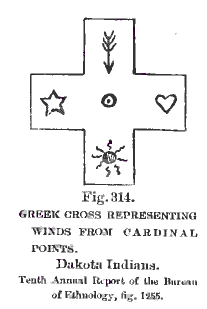

The Swastika
The Cross Among The American Indians
Throughout this paper the author has sought but little more than to prepare
 material
on the Swastika which can be utilized by those who come after him in the
determination of the difficult and abstruse problems presented.
material
on the Swastika which can be utilized by those who come after him in the
determination of the difficult and abstruse problems presented.It is rare in the study of archæology and, indeed, in any science, that a person is able to assert a negative and say what does not exist. The present investigations are rendered much more comprehensive by the appearance of the extensive and valuable work of Col. Garrick Mallery in the Tenth Annual Report of the Bureau of Ethnology, on the subject of "Picture Writing of the American Indians." It is a work of about 800 pages, with 1,300 illustrations, and is the result of many years of laborious study. It purports to be a history, more or less complete, of the picture writing, signs, symbols, totems, marks, and messages of the American Indian, whether pictographs or petroglyphs. A large portion of his work is devoted to ideography, conventional signs, syllabaries and alphabets, homorophs and symmorophs, and and their respective means of interpretation. Among these he deals, not specifically with the Swastika, but in general terms with the cross. Therefore, by looking at Colonel Mallery's work upon this chapter (p. 724), one is able to say negatively what has not been found.
Apropos of the meanings of the cross among the North American Indians Count Goblet d'Alviella says: (1)
It is nevertheless incontestable that the pre-Columbian cross of America is a "rose des vents," representing the four directions whence comes the rain, or the cardinal points of the compass, etc., etc.
Colonel Mallery's volume shows that it meant many other things as well.
The four winds. --- The Greek cross is the form found by Colonel Mallery to be most common among the North American aborigines, possibly because it is the simplest. In this the four arms are equal in length, the sign placed upright so that it stands on one foot and not on two, as does the St. Andrew's cross. The Greek cross (fig. 314) represents, among the Dakotas, the four winds issuing out of the four caverns in which souls of men existed before the incarnation of the human body. All the medicine men --- that is, conjurers and magicians --- recollect their previous dreamy life in these places,and the instructions then received from the gods, demons, and sages; they recollect and describe their preexistent life, but only dream and speculate as to the future life beyond the grave. The top of the cross is the cold, all-conquering giant, the North Wind, most powerful of all. It is worn on the body nearest the head, the seat of intelligence and conquering devices. The left arm covers the hear; it is the East Wind, coming from the seat of life and love. The foot is the melting, burning South Wind, indicating, as it is worn, the seat of fiery passion. The right arm is the gentle West Wind, blowing from the spirit land, covering the lungs, from which the breath at last goes out gently, but into unknown night. The center of the cross is the earth and man, moved by conflicting influences of gods and winds.
Rev. John McLain, in his work on the "Blackfoot Sun-dance," says:
On the sacred pole of the sun lodge of the Blood Indian is a bundle of small brushwood taken from the birch tree, which is placed in the form of a cross. This was an ancient symbol evidently referring to the four winds.
ENDNOTES:
1. "La Migration des Symboles," p. 18. [Back]
<< Previous Page Next Page >>
© 2004-2007 Northvegr.
Most of the material on this site is in the public domain. However, many people have worked very hard to bring these texts to you so if you do use the work, we would appreciate it if you could give credit to both the Northvegr site and to the individuals who worked to bring you these texts. A small number of texts are copyrighted and cannot be used without the author's permission. Any text that is copyrighted will have a clear notation of such on the main index page for that text. Inquiries can be sent to info@northvegr.org. Northvegr™ and the Northvegr symbol are trademarks and service marks of the Northvegr Foundation.

|